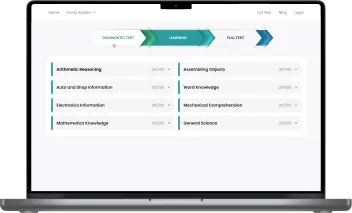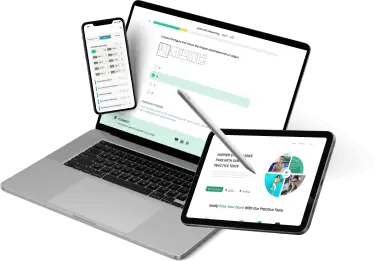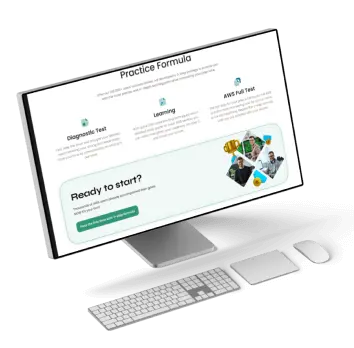Fun & effective HSPT practice test tool to pass with flying colors
All-in-one platform with everything you need to ace the HSPT on your first attempt
Clear and Thorough Learning Path
Proven HSPT 3-step Practice Formula
After our 100,000+ users' success stories, we developed a 3-step strategy to provide you with the most precise and in-depth learning path while minimizing your prep time.HSPT Diagnostic Test
First, take this short test and get your detailed report showing your strong and weak areas. Save your time by concentrating on what is in demand.Learning
With quick, bite-sized learning techniques and a detailed study guide for each HSPT section, you can really strengthen your weaknesses (from step 1) and boost your scores.HSPT Full Test
The last step for your preparation is taking our full HSPT practice tests and seeing how far you've come since the beginning. Repeat the 3-step formula until you are satisfied with your results!Ready to start?
Thousands of HSPT users already accomplished their goals.NOW it’s your turn!

What You Get

All-in-one platform
A complete HSPT Prep Platform, including a diagnostic test, detailed study guides for all topics, practice questions with step-by-step explanations, and various full simulator tests.
Questions nearly identical to those in the real HSPT test
All questions are categorized into the specific sections as on the real HSPT: Same format & same difficulty!
Best for the busy
Easily & quickly grasp all the knowledge with our unique learning technique. And you can learn anytime, anywhere on any devices, even with a few free minutes.
Practice while having fun
Learn and play! Complete round-by-round to reach your daily achievement and make progress on your learning journey!Featured on















What our users are saying
Over 50,000 aspiring American candidates use HSPT monthlyFREE HSPT Practice Test 2024 | The Comprehensive Guide
Welcome to HSPT Practice Test, a free website that is dedicated to helping with your test prep. Prepare for your test by using our online HSPT practice tests in 2024!
Our HSPT practice tests are a great way to brush up on your skills for free. For a run-through of frequently asked questions, take one of our many HSPT practice tests. At the end of your HSPT practice test, you will receive extremely detailed scoring results that will help you identify your strengths and weaknesses.
What Is The HSPT Test?
The High School Placement Test (HSPT) is an admission test for eighth-graders interested in attending Catholic high schools. Based on the exam results, schools make admissions decisions, place applicants, and grant scholarships.
Students must apply for the high school placement test directly with the school to which they are applying. The exams were conducted at the schools themselves, rather than at a testing center. Students should confirm precise registration procedures with their target schools.
To be considered for admission, students need to take the exam at only one Catholic school. If a student takes the HSPT more than once, the lower score is used to determine the final score.
HSPT Test Sections
Verbal Skills
The 16-minute verbal skills section is meant to assess your ability to perform reasoning tasks that require the use of words. This is a core ability that applies to a wide range of content areas, including language, reading, and social studies. This section covers analogy, logic, verbal classifications, synonyms, and antonyms, among other topics.
Quantitative Skills
The quantitative component, which lasts 30 minutes, evaluates your ability to solve mathematical and quantitative reasoning questions. This section of the exam examines the cognitive skills you've acquired in the classroom and in your everyday life. Sequence, reasoning, geometric comparison, and non-geometric comparison are some of the topics covered in this section.
Reading
The 25-minute reading section assesses your overall reading comprehension, recognition of essential facts and ideas, ability to identify central thoughts and premises, logical inference skills, and vocabulary understanding in context. Some of the topics included in this section include comprehension, vocabulary in context, inferential comparison, literal comparison, critical composition, drawing conclusions, main idea, reasoning, implied characterization, author purpose, predictions, fact vs. fiction, compare/contrast, and vocabulary.
Mathematics
The 45-minute Mathematics section is meant to assess your ability to perform arithmetic operations, apply essential math concepts, and solve problems using sound mathematical reasoning. Some of the topics included in this section include numbers and numeration, geometry, statistics, algebra, measurements, and probability.
Language Skills
The 25-minute language skills section assesses your knowledge of proper English language capitalization, grammar, punctuation, usage, spelling, and composition. Some of the topics of this section include capitalization, punctuation, noun/pronoun, verb/adverb/adjective, correct/incorrect usage, other parts of speech, composition, and spelling.
How Many Questions Are On The HSPT?
The HSPT exam consists of approximately 300 multiple-choice questions. Each question has three or four answers. Here's what to expect from each HSPT section.
Verbal Skills
|
Time Limit |
Content Area / Skills |
Number of Questions |
|
16 Minutes |
Verbal Analogies |
10 Questions |
|
Synonyms |
15 Questions |
|
|
Logic |
10 Questions |
|
|
Verbal Classifications |
16 Questions |
|
|
Antonyms |
9 Questions |
|
|
TOTAL |
60 Questions |
Quantitative Skills
|
Time Limit |
Content Area / Skills |
Number of Questions |
|
30 Minutes |
Number Series |
18 Questions |
|
Geometric Comparison |
9 Questions |
|
|
Non-Geometric Comparison |
8 Questions |
|
|
Number Manipulation |
17 Questions |
|
|
TOTAL |
52 Questions |
Reading
|
Time Limit |
Content Area / Skills |
Number of Questions |
|
25 Minutes |
Comprehension |
40 Questions |
|
Vocabulary |
22 Questions |
|
|
TOTAL |
62 Questions |
Mathematics
|
Time Limit |
Content Area / Skills |
Number of Questions |
|
45 Minutes |
Concepts |
24 Questions |
|
Problem-Solving |
40 Questions |
|
|
TOTAL |
64 Questions |
Language Skills
|
Time Limit |
Content Area / Skills |
Number of Questions |
|
25 Minutes |
Punctuation and Capitalization |
12 Questions |
|
Usage |
28 Questions |
|
|
Spelling |
10 Questions |
|
|
Composition |
10 Questions |
|
|
TOTAL |
60 Questions |
How Long Is The HSPT Test?
The HSPT takes approximately two hours and 30 minutes to complete.
Is The HSPT Test Hard?
The HSPT is really difficult, thus you'll need to study hard to succeed: you can't just think of yourself as a math or language person. To be as well-rounded as possible, you need to study.
HSPT Scores
What is a Good HSPT Score?
Scores on the High School Placement Test (HSPT) are given as percentiles. The 76th through 99th percentiles are considered high, the 24th through 75th percentiles are considered average, and the 1st through 23rd percentiles are considered low. The HSPT score at the 50th percentile is considered to be precisely average. As a result, a good HSPT score is usually above 75.
How Does the HSPT Scoring System Work?
The HSPT exam is split into subtests. The raw score is calculated by adding the number of correct answers from each subtest. There is no negative marking. Each subtest's raw score is then converted to a standard score. The standard score of each student is compared to a national sample of students' test results.
For each subtest, a national percentile ranking (NPR) is calculated. The national percentile ranking shows how many students in the sample scored lower than you. If your NPR is 39, for example, it means you surpassed 39% of students in the same sample. If you got a 92 percent, you surpassed 92% of the exam takers worldwide. A student's percentile score may range from 99 to 1, with 99 being the highest and 1 being the lowest.
What Skills are Measured by the HSPT?
The HSPT evaluates the following skills:
Cognitive Skills: Cognitive skills include quantitative skills and verbal skills.
- Verbal skills denote your ability and skills in language and social studies.
- Quantitative skills are your reasoning and problem-solving skills in subjects involving numbers and quantities, such as mathematics and science.
Basic Skills: Basic skills include mathematical, language, and reading skills.
- Reading skills entail skills in interpretation, inference, comprehension, and vocabulary strength.
- Mathematic skills indicate problem-solving abilities using mathematic calculations.
- Language skills include your ability to apply language rules like punctuation and grammar.
How is the HSPT Scored?
These scores are calculated the same way that the national percentile ranking (NPR) uses. The HSPT test includes a series of quantitative, mathematical, verbal, reading, and language subtests. Students receive scores for each HSPT subtest. These individual subtest scores are combined to create a Total Cognitive Skills score, a Battery Composite score, and a Total Basic Skills score.
- Total Basic Skills Score: This score is the sum of scores in language, mathematics, and reading subtests.
- Total Cognitive Skills Score: This score is a total of the scores earned in the quantitative and verbal subtests.
- Battery Composite Score: This score is a total of all the subtest scores (i.e., the scores in language, reading, verbal, mathematics, and quantitative).
Composite scores are the total of these three scores. They are then converted into standardized scores, which are then converted into national percentiles.
Optional tests in science, religion and mechanical aptitude may be given by some schools. The results of optional tests are not included in the Battery Composite Score if a school decides to use them.
How are the HSPT Results Distributed?
HSPT provides two types of test results: a Student Score Report and a Performance Profile. These are not made available to students directly. Instead, the schools that conduct the test must pay for the results.
What Does the HSPT Student Score Report contain?
The national percentiles of each subtest and composite test are clearly shown in the HSPT Student Score Report. The following scores are included in the HSPT score report:
- Cognitive Skills Quotient (CSQ): is a test that determines your age-related learning ability and skills. The CSQ score can range from 55 to 145, with an average of 100.
- Grade Equivalents (GE): it compares your reading, math, and language skills to those of students in your grade level.
What Does the Performance Profile Contain?
The Performance Profile includes a table of test scores on various scales, including local percentile, national percentile, GE, and CSQ. It also includes ratings for each area's performance. Different tables at the bottom of the profile list the specific skills measured by each subtest. They present the number of questions answered correctly for the items corresponding to each specific skill to show the student's potential in these skills.
How are HSPT Results Used?
The results of the HSPT test are used by high schools in admissions, scholarship, and placement processes. If you want to earn a scholarship at a private high school or get admission to a prestigious high school that requires students to apply, you may need to take the HSPT. The HSPT results may also help determine the courses you should take in high school. You'll want to perform your best so that you have as many options as possible when high school begins.
HSPT Score Summary
|
Score Type |
Score Range |
Details |
|
Raw Scores |
Verbal: 0-60 Quantitative: 0-52 Reading: 0-62 Mathematics: 0-64 Language: 0-60 |
The total number of correct answers in each section determines the score. |
|
Standard Scores |
Verbal: 200-800 Quantitative: 200-800 Reading: 200-800 Mathematics: 200-800 Language: 200-800 |
These scores are the result of converting the raw section scores into a scaled score. |
|
Percentile Rankings |
Verbal: 1-99 Quantitative: 1-99 Reading: 1-99 Mathematics: 1-99 Language: 1-99 |
These results were released on a national and local level. These numbers represent the percentile conversion of each section's raw score, i.e. what percentage of students scored lower than you. |
|
Composite Scores: Total Cognitive Skills |
200-800 & 1-99 |
The standard scores and percentile rankings for the Total Cognitive Skills group, which comprises the Verbal and Quantitative Skills sections, are reflected in these scores. |
|
Composite Scores: Total Basic Skills |
200-800 & 1-99 |
The Total Basic Skills group, which comprises the Reading, Mathematics, and Language sections, has standard scores and percentile rankings. |
|
Composite Scores: Battery Composite |
200-800 & 1-99 |
The Battery Composite group, which includes all five sections, received standard scores and percentile rankings. |
HSPT Registration
The High School Placement Test may be required of applicants to certain high schools (HSPT). Different schools give the tests, and each school has its own registration process.
Individuals should contact the school where their test will be conducted to find out how to register. They can obtain this information by emailing or calling the school. Some schools also provide information about the different registration options on their sites.
Online Registration
Individuals can use an online registration system at some institutions. Individuals can pay for their exams with a credit card using these systems. If necessary, individuals can also choose a test date and location. Those who register for the HSPT through the Archdiocese of a specific city or region, for example, may have several options for where they might take it.
Phone Registration
Individuals who are unable to register online or who prefer a different registration option may be able to register by phone.
Walk-In Registration
Some schools allow individuals to arrive on test day and register and pay for the HSPT on the spot. Individuals who opt to pursue a walk-in registration have no guarantee that they will be admitted to the test, however. If there isn't enough space on that day, they may not be able to take the HSPT then.
What to Bring on Test Day
There are a few things that HSPT test takers should bring with them on the day of their exam.
Payment
Individuals must bring the test fee with them unless they paid online when they registered. The payment of cash is accepted.
Pencils
On the day of the HSPT, students should bring two sharpened No. 2 pencils.
Confirmation Code
A confirmation code will be sent to those who register online. When these examinees check-in on test day, they should have that code with them.
Identification
The requirements for identification may differ from one school to another. Individuals who did not register in advance may need to have accepted forms of identification. Check with the testing center to see whether the forms of identification are required.
How to Apply for Accommodations
Some people who are planning to take the HSPT exam may be eligible to have their test modified or the testing conditions changed. This is referred to as accommodations. Individuals with specific needs stemming from a disability, a medical condition, or speaking English as a second language are often offered these.
Individuals who believe they may be eligible should contact the school or diocese where they will be taking the HSPT to learn about the school's specific accommodations policies and how to apply for them. Because some schools have a deadline for requesting for accommodations, it's essential to get started as soon as possible.
Examples of Adjustments Offered
Specific exam accommodations may vary from one school to another. The following are examples of common adjustments:
- Extra test time
- Receiving the test in Braille
- Taking the exam in a separate room
- Use of resources like a calculator
- Getting a large-print version of the test
- Having someone read the test questions to you
- Take extra breaks during testing
- Oral ability to answer test questions
How Many Times Can You Take HSPT?
The High School Placement Test (HSPT) evaluates students' knowledge and skills in preparation for high school admissions, scholarships, and placement. Students preparing to take the HSPT exam may be concerned about whether or not they will be able to retake the exam if they do badly; however, there is no defined policy for retaking HSPT tests.
The school where a student took the test will determine whether or not they can take it again. If there are extenuating circumstances, a school or diocese may allow a student to retake the HSPT test. Each situation is examined separately, and the school or diocese will take into account the factors that are relevant to that individual's request to retest.
There are no clear guidelines on what, if any, restrictions may apply to individuals retaking the HSPT test because there is no standard retake policy in place. The school or diocese where the student is taking the test makes the decision on how long a student must wait to retake the HSPT.
HSPT Tips to Pass The Exam
Break it down
Because the HSPT has approximately 300 questions divided into five sections, dividing the test into its components is one of the most effective study strategies. If you begin your preparation with the Math section, study these concepts before moving on to the Verbal section.
Individually studying for each section might help you reinforce and improve your HSPT content understanding. Review the sections you've already covered at the beginning of each study session. Prepare early rather than later.
Practice, practice, practice
While taking practice tests after practice tests can be tiresome, it is an excellent way to prepare for the HSPT. Practice exams can assist you in a variety of ways. To start, you have established your time. Each section of the exam has a time limit, therefore the more you practice finishing the HSPT within this window, the faster you will become.
Practice exams might also assist you in identifying your weak areas. You'll soon identify where your knowledge gaps are — whether you need more Math help, or a special kind of Reading question is giving you trouble.
Write it down
Start writing down what you learn once you've determined where you're having trouble. This could include creating an outline for subsequent review or making flashcards to use throughout your preparations. Our brains are more likely to remember information once we write it down. Find a method that works for you and apply it to all of the HSPT sections.
Avoid procrastination
It's risky to put off studying until the week before the HSPT. This, however, rarely, if ever, pays off. As soon as you have your test date, start studying. This allows you to spend enough time on each section.
Create a pre-planning plan and adhere to it to avoid procrastination. Make sure to include research goals and track your progress toward them. If you are not accomplishing these goals, it may be time to rethink your study plan.
Designate a study space
Make an effort to create an atmosphere that nurtures good study habits. This could mean moving your desk to a quieter room or locating a library that has hours that work for you. Your ultimate goal should be to discover a space where you can study successfully and maximize your prep time.
Read a book
Reading is another excellent strategy. Reading can help you learn new vocabulary words, improve your comprehension skills, and improve your grammar and syntactic understanding.
Prepare for your test session
You may be nervous on the day of your test. This is totally natural. Get enough sleep the night before the HSPT and eat a good breakfast to maximize your success. These tips may assist you in passing the HSPT! Remember that you have prepared for this day - you are more prepared than you may think – so be confident and demonstrate your knowledge to the HSPT. Only a few hours will separate you from success!
HSPT Exam Test-Taking Tips
- Get plenty of sleep the night before the exam and make sure to have a healthy breakfast.
- Before you look at the answer, read the question.
- Before looking at the possible answers, come up with an answer in your brain so that the exam choices don't confuse or trick you.
- Before selecting an answer, read through all of the choices.
- Always an answer based on an educated guess.
- Don't keep changing your mind; your first choice is typically the best.
- After you've completed your test, check it. If you have time, try solving the problem again on a different piece of paper to see if you get the same answer. Make sure the decimal is in the right place, read the directions correctly, copy the numbers correctly, fill in the wrong numbered bubble for an answer, and so on.
- When time is limited, start with the easiest problems and work your way through them.
- Bring a watch to the test so you can keep track of your timing.
- Keep a positive attitude and try to stay relaxed throughout the test; if you start to feel nervous, take a few deep breaths to calm down.
- Always read the entire question without making any assumptions about what it might be about.
- If you don't know the answers to those questions, skip it and continue with the rest of the test. There might be something on another specific test that can help you answer that question.
- Don't be worried if others finish before you; concentrate on the task at hand.
- If you have time once you've finished, go over your test. Make sure you've answered all of the questions, and only change an answer if you misread or misrepresented it.
- Relax and just do your best, that is all you can ask of yourself!
FAQs - HSPT practice test
Does the HSPT have an essay?
The HSPT does not require you to write an essay, but the school to which you are applying may need you to write an essay on a topic of their choosing as part of your application.
Can you fail HSPT test?
The HSPT test can be failed. The results are sent to the school where your child applied, and they are used to make a decision. No scores will be given out after January 3rd, so whether your student takes the exam in October or later, you'll know whether or not they passed by February 1st. If they didn't pass the first time (or even if they came close), they should retake the test in January, when they will have access to more preparation materials, as their application has already been submitted.
What Math is on HSPT?
Section design for the HSPT Mathematics test You have 45 minutes to complete the Mathematics test, which consists of 64 multiple-choice questions. Your ability to answer questions in arithmetic, geometry, and algebra is tested in the Math section.
Is the HSPT test on paper or computer?
The test is given on paper (not on a computer) at one of the schools you're applying to, and it takes between 2.5 to 3.0 hours to complete, depending on the length of breaks and how long it takes to get started. Calculators are forbidden. You don't need to write an essay.
Conclusion
The High School Placement Test, or HSPT, is required by many parochial and private high schools. The majority of students that take it to do so in eighth grade, as the test can decide whether or not a student gets accepted.
Therefore, don’t forget to take our free HSPT practice test to get familiarized with the format as well as the questions of the actual exam to strengthen your knowledge and skills, as a result, enhancing your chance to pass the HSPT exam with a high score on your first attempt. Good luck to you!






